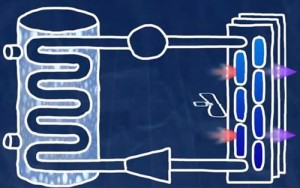
A heat pump can be defined as an air conditioning system that moves heat both to and from a conditioned area.
Through the proper use of controls, these units may be used during all seasons of the year.
During the cooling season, the unit functions as a regular cooling unit. During the heating season, however, the refrigerant flow is reversed, and it becomes a heating unit.
Heat pumps are classified according to their heat source and the medium to which the heat is transferred during the heating season. The most common is called air-to-air.
Cooling Cycle
During the cooling season, the heat pump operates as a normal cooling system.
The refrigerant is compressed by the compressor and discharged to the outdoor coil called a condenser, where it is condensed to a liquid.
It then travels to the flow control device and into the indoor coil called an evaporator, where it is evaporated and absorbs heat; then back to the compressor, and the cycle repeats.
Notice the names of the coils have changed. This is to eliminate confusion when discussing heat pumps.
The evaporator is termed the indoor coil, and the condenser is termed the outdoor coil. As the season changes, the functions of the coils change.
Heating Cycle
During the heating season, the heat pump operates because of the reversed refrigerant flow.
The refrigerant is discharged by the compressor into the indoor coil, where it is condensed into a liquid refrigerant.
The heat removed from the refrigerant is discharged into the conditioned area. The liquid refrigerant is then directed to the outdoor coil, where it is evaporated before returning to the compressor.
It should be noted that the reversed flow is accomplished by the use of a four-way valve and check valves.
Some manufacturers will use different variations of this setup, but all accomplish the same thing.
The indoor coils used with heat pump units are usually designed especially for heat pumps, and many times a coil is designed for a particular model unit.
In most instances, the indoor coil used on a regular cooling unit will not function properly on heat pump installations.
This is because of the reduced airflow over the indoor coil. The proper refrigerant-to-air ratio must be maintained for economical performance.
Defrost Cycle
During the heating season, it’s quite possible that the outdoor coil will operate at a temperature below freezing.
At this temperature, any moisture which may be removed from the air will immediately freeze on the surface of the coil.
This frost on the coil will continue to build up and cause the outdoor coil to lose its efficiency. This frost will also act as an insulator, which will reduce heat transfer and reduce coil efficiency even more.
When the coil efficiency has been reduced enough to affect the performance of the system, the frost must be removed.
Heat strips are often used to bring the coil back into the desired temperature range.
Heat strips work the same way a space heater would but within a heat pump unit.